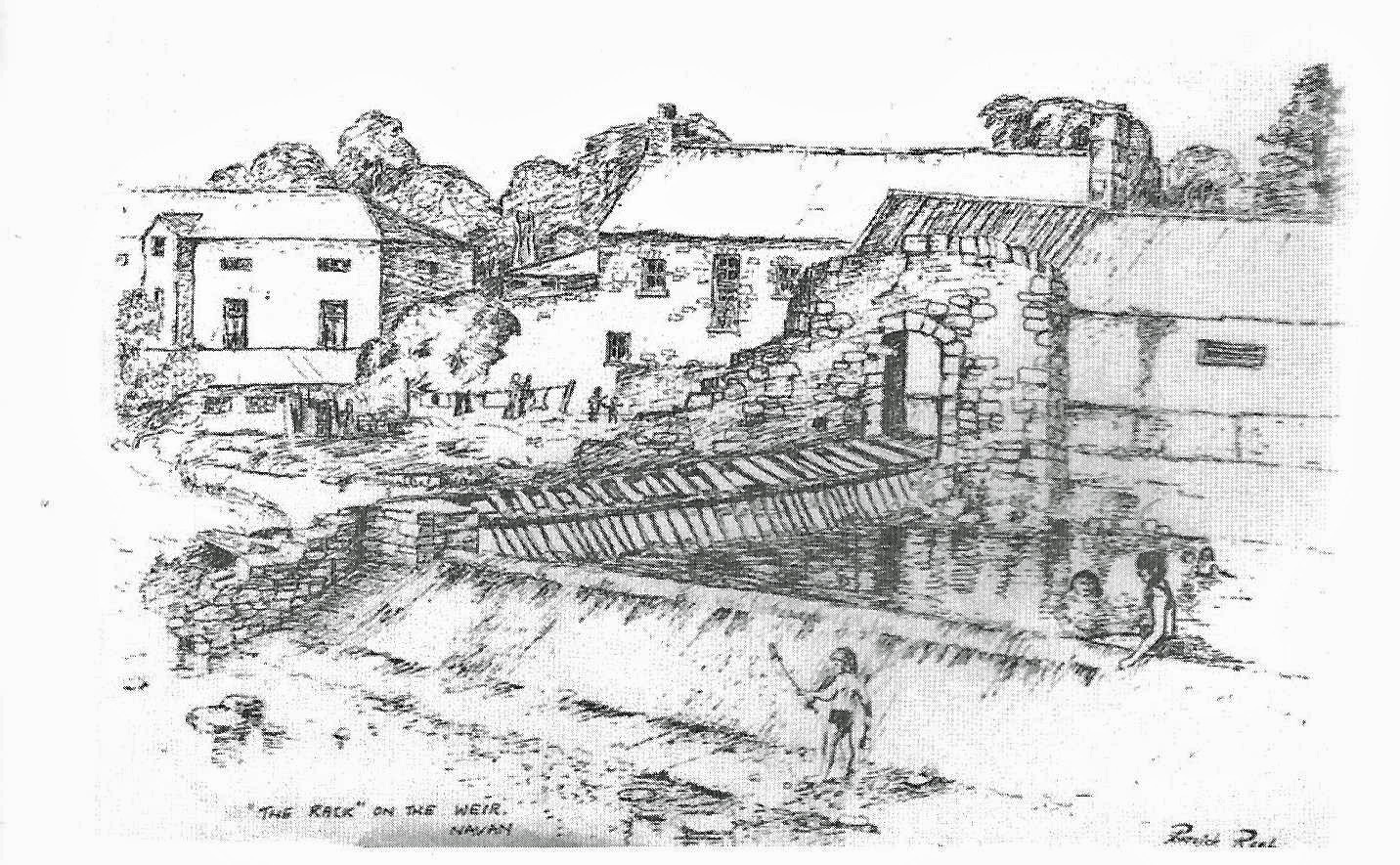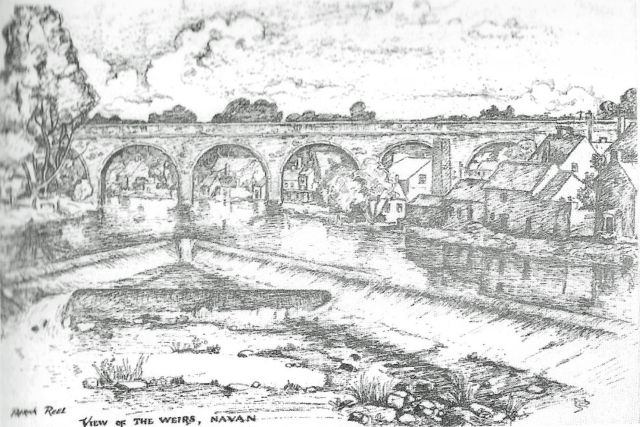Memories of the Weirs
Memories of the Weirs
By Paul McGillick
_______________________________
I suppose that an author or contributor should ensure that his or her thoughts are put in context of time and happenings so that a future researcher can access and probe and use information and material gleaned from the original article and be fairly well assured of its accuracy. We are told, as well, that the memory does not improve with time. However, there are formative memories of youth which will never fade.
A short while ago I put together a brief paragraph in relation to my experiences, as a child, of swimming at the Weirs (the weir, of course, but bear in mind we are 'at' Navan now). The four sentences more or less described to a T what I really thought, even at that time. I was neither a very brave swimmer, nor was I a strong swimmer, unlike generations of Navan youth before and after me, but we will return to that.

Fig 1 ‘The Rack’ on the Weir Navan by Patrick Reel
(reproduced with the kind permission of Patrick Reel)
As I pen this article I have in front of me, six images, beautifully printed in A4 landscape, of the places to which I refer. How lucky we are, in Navan and district, to have the various images which have survived through the years, from the days of the Lawrence collection to the postcard images of various locations along the Boyne. In addition, not only are a set of pictorial images available, but those very images, via the genius of Patsy Reel, capture the very essence of the subjects and times portrayed therein.
Initially, I had put a few words together, based on my memories as a child, and such memories were not overly complimentary of the weir. My memories of cold water, of the continual noise of the Boyne as it flowed over the salmon leap and of the collection of the flotsam and jetsam of river life trapped at the rack, while memories of mine, may not be shared by many who would read those initial words. I’m sure a lot of the old natives would remonstrate with me and suggest that I did not know the weir at all...but such is the nature of one’s individual memories.
Is it our imagination or were the summers of the 1960s and seventies so much better than the ones we have now? Perhaps it was the advantage of carefree youth, but I never remember anything except blue skies and summer heat while at the river. We younger ones would make our way over to the rack and there swim to our hearts content. I remember the old swimming pool, I was terrified of it, my memories are of blue painted surround and stepped sides. The water always seemed dirty to me and in all my time I never put as much as a toe in it. The pool itself was surrounded by long grass and many’s the liaison, illicit and otherwise, was rumoured to take place there but we were too young to be bothered by such trivia. We were aware, as well, that the hardy boys swam in the old canal. Many times over the years have I been reminded of the old lock gate, which I remember well, and we would stand in awe as the older boys and men would dive down into the depths, swim under that lock gate and emerge triumphant on the other side. Those were heady times in what I believe was eighteen feet of water.
I remember my first day as a young boy at the weirs. I was at the bank, holding on for dear life, never having swum before. It was cold and the never ending sound of the water swirling and crashing over the walls of the various weirs did little to improve my confidence. One of the lads with me was an accomplished swimmer and was quite comfortable in the water but when some passing buck laughed at me and suggested that I would be better off on the bank in the sun I threw caution to the winds and struck out for the first time. Whoever he was, he was the one who first saw me swim. It seemed like an eternity to reach the far wall, but that was it, I could manage thereafter. We were always conscious of the dirt around the rack and would take great care while down at that end. I remember one day, finding my way out to the V of the weir itself and sitting in the water as it cascaded over, it was a great feeling, but I was still nervous of the wide expanse of water.
My swimming was done there in the 1960s. I hope that somewhat older men and women, if they read these few words would be encouraged to come forward and compare and contrast their own memories from the forties and fifties, being conscious that poor handwriting is still far superior to a good memory any old day. I’m sure that many remember diving under that lock gate and even more remember the man, before my time, who would swim all the way to Kilcarn Bridge and then float back down to the very weir, on his back, reading the newspaper. Now, don’t ask me how he kept it dry on the way up, but he did exist, he will be remembered by many of his era.

Fig 2 View of the Weirs Navan, by Patrick Reel
(reproduced with the kind permission of Patrick Reel)
Of course, there were other attractions at the water besides the immersion of the body. Generations fished there, and I was also one of those. I walked with my father, of course, but remember great days with Tom Brady Senior, and his son, Tom, both now deceased. We would walk over the railway, ah the good old relaxed days, looking forward to setting rod and line and I would make my way to the dead lake blissfully unaware at that time that I was passing the grave of my little brother who lay peacefully in Old Athlumney.
A couple of years later, and my interest in the river changed, as did my perspective. The Reillys have lived for generations "back to the river" and I spent a long hot and happy summer at Academy Street while my sister’s house was being built. The land and yard went right to the river itself and when the long day's work would be done, the blue boat would be taken out and up the river towards Kilcarn we would go.
Funny enough, although that couple of years had passed, my feelings in relation to wide expanses of water had not, and I was always concerned, especially on the way back, that the sturdy hands of Seamie would falter and the boat would cross the wier. I might not have worried, there was no danger. We snatched minnows and fished for eels and enjoyed the river on long summer evenings.
I find the old photographs fascinating. One of the collection shows the remains of old cottages on the left hand side, just beside what I remember as Reilly’s hen house, the boats, there were two, just beyond. Little did I know then that my Grandmother, Mary Anne Lynch, as a young girl, had lived there.
Another, also taken from the bridge, shows the reeds and rushes just above the weir and yet another gives an idea, for those who did not experience it, of the huge expanse of water which flowed down from the direction of Kilcarne Bridge, over the weir, flowing left to join the Blackwater and right to feed the old canal with the water which was essential for both its commercial life, and indeed at one time the commercial life of Navan itself.
Of course, the very river which contributed much to the town, indeed to the very formation of the town in times past, had its own teeth too. While children played and swam in the lazy days of summer, the residents of Butterstream and Academy Street would anxiously watch the winter weather and water levels, - houses, workshops and livelihoods being under threat during times when the river would flood. I remember going to the bridge as a very young child and watching the men of Navan Fire Brigade as they tirelessly pumped to clear houses and street. Our little Dennis 8, ZN 869, which I still have the pleasure of driving occasionally, would sit for hours and days, pumping away with its four litre Rolls Royce engine, so that residents might be able to return home.
And, of course, that brings me, in any case, to the late 1960s. I remember watching, from the back of the Reilly workshop, the two massive machines as they commenced the work on the changing of the river bed and what was the initial work on the Navan Ring Road. Two modern day dinosaurs, with buckets on chain, which bit deep into the bed of the Boyne and tossed their contents, three tonnes at a time. The clattering of chains, the bucket being dragged along the river bed and then rising with engines protesting the strain and water escaping, as the very action heralded the impending changes to the river and indeed to the town itself. Progress, ah progress, but when I think now, of the various weir walls and the then layout of the river, I sometimes wonder, was there any other way? Maybe not.
Where I wandered as a boy, and to me a lasting joy...
Well, as I mentioned earlier, returning to my efforts at swimming, I was never the most skilful nor the most confident. Some brief time after my first foray into the water, I struck gold via Gormanston College. Unlike a lot of Navan and Meath lads, I was never a student, but was lucky to have access to the swimming pool there over a number of years. And despite the lure of the Boyne, the clear water and the airy grandeur well remembered over summers of youth, I found that I was more than willing to trade such wondrous freedom for a pool full of heated water, with beautifully tiled walls and floor, a shallow and deep end, coupled with a diving board and dressing rooms.
Alas, my days at the rack were over.